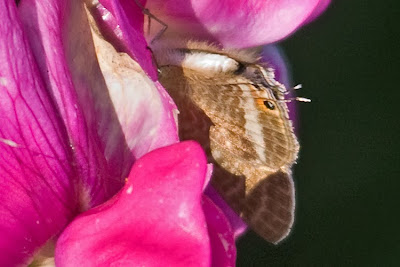Back on August 14th, when two of my Grandsons, Jack and Josh, were staying with us, we managed to see three of the Long-tailed Blue butterflies that had been found on Kingsdown Lees earlier in the month.
Long-tailed Blue (Lampides boeticus)
I had seen this species before, in about 1990, when some were discovered on railway land at the back of Gillespie Park Nature Reserve, in Islington, where they were on bladder senna (Colutea arborescens). Like these they were pretty worn and I didn't manage to see a really fresh "blue one". The one above was on plants of Lathyrus latifolius, everlasting pea, a garden escape that is prolific along the cliff top here.
This one was in slightly better condition, but still a long way from being in prime condition. On the day we were there at least one female was observed laying eggs so it has been a case of waiting for the next generation to arrive. The news came out that one or more had been seen last weekend, but in the dull weather over the weekend I didn't manage to see any.
The sunshine this afternoon seemed a good omen and I went to see if I could find any. Quite a few other butterfly enthusiasts had the same idea and when I arrived the news was that several had been seen.
After a while one appeared sunning itself on the Lees, near Ship House.This one was quite definitely blue, but was quite flighty and not keen on close approach.
This one was still nothing like a perfect specimen, but was showing the main characters, without having the eponymous long tails.
A close view showed that it did indeed have some tails, but that these were worn and comparatively short.
When I was alerted to the fact that a male with full long tails had been found I took a quick photo in case it flew and wasn't found again. The light is from the wrong direction and the wings are nearly closed, but the white tipped "tails" are in full view.
I think that the underside of this butterfly, quite unlike any of our resident blue butterflies is particularly attractive with its wavy pattern.
Below are some images of this particular individual. As they do not usual survive the winter north of the Mediterranean it is improbable that even if this new generation lays eggs that they will be around next year.
Below are some images of this particular individual. As they do not
usual survive the winter north of the Mediterranean it is improbable
that even if this new generation lays eggs that they will be around next year.
In countries where they are resident, in Southern Europe, Africa, Asia and Australia, they are able to breed continuously and cam become a pest species where peas are grown.
They are a distinctly different colour to the other blues hear and also have a rather characteristic jerky flight, making then very difficult to follow once they are in the air.
Against the plain background the tails are very obvious, although they are more difficult to see when the butterfly is on a pea flower.













1 comment:
Hi Tony,
It was good to meet with you on Monday at Kingsdown. I did get to see the male Long Tailed, which was a real thrill, even if I did not get a clear shot of it.
Just want to say thanks for the heads up from you via your blog.
Cheers,
Ian
Post a Comment